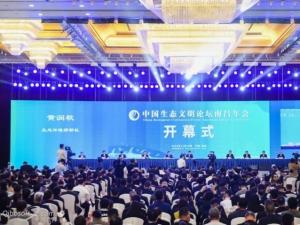Patrick Schroeder:CBDR and problems in Social ecology-enforcement at national and global level
|
CBDR and problems in Social ecology-enforcement at national and global level "Operationalising Common but Differentiated Responsibilities and Respective Capabilities (CBDRRC) in the climate change negotiations and EU-China climate change cooperation" Patrick Schroeder[1]
[1]PhD Environmental Studies,Senior International Advisor to the China Association for NGO Cooperation (CANGO) and China Civil Climate Action Network (CCAN)GIZ/Centre for International Migration and Development (CIM).
帕特里克.施罗德 摘要:本文将从中欧合作、联合国气候变化公约进程的角度出发,就与发展权利相关的共同但有区别责任原则以及气候变化保护要素进行讨论。其将就多边气候变化协商中,发展权利如何被阐释为“平等享有的可持续发展权”进行探讨。另外,本文也将就各国对气候变化的贡献、欧盟和中国气候保护的能力以及国际责任进行探讨。同时,本文将对当前国际气候变化谈判的情况进行概括总结,并就在平等原则以及共同但有区别原则的标准方面达成共识对气候变化国际合作进程推动的重要意义进行阐释。最后,本文将以中欧合作、确保发展中国家以及后代人的可持续发展权利的方式作结。
This short paper discusses elements of CBDRRC and global climate protection in regard to the right to development which are relevant for the UNFCCC process and EU-China cooperation. It looks specifically at how the right to development is addressed and framed as ‘equitable access to sustainable development’ in the multilateral climate change negotiations. Furthermore, it discusses national contributions to climate change and international responsibilities and capabilities to act for climate protection of the EU and China. Furthermore, it looks at the current situation in the global climate change negotiations and how an agreement on equity principles and metrics for CBDRRC are necessary in moving the process forward. It concludes with recommendations how the EU and China can cooperate more closely to ensure the right to sustainable development for developing countries and future generations.
It is still a common perception that environmental protection (including climate protection) and economic development are a dichotomy. It is true that environmental protection is at odds with the type of economic development that was pursued in the past. This type of ‘business-as-usual’ development still determines most of today’s global economic activities. However, at the beginning of the 21st century many local economies and companies already demonstrate that it is possible to run profitable businesses while protecting the environment at the same time. It is clear that business-as-usual industrial development has reached, and in some cases has already overshot, the planet’s limits which need to be respected to ensure well-being for future generations. Environmental protection is not anymore only about protection pretty scenery, but protection of the civilization as we know it. In 2009, a group of 28 internationally renowned scientists associated with the Stockholm Resilience Centre identified and quantified a set of nine planetary boundaries within which humanity can continue to develop and thrive for generations to come. Crossing these boundaries could generate abrupt or irreversible environmental changes. Respecting the boundaries reduces the risks to human society of crossing these thresholds. Three of these boundaries have already been crossed: biodiversity loss, nitrogen inputs to oceans and the biosphere, and climate change.[1] The challenge of decarbonising the global economy is the most pressing environmental, economic and political challenge of the 21st century. Contrary to conventional belief, the cost of decarbonisation is not as high as often perceived, especially if early action is taken. Immediate climate policy can contain the mitigation costs at less than 1% of global GDP, even if the CO2 concentration target is 410 parts per million (ppm) by 2100.[2] Delayed climate policy increases the costs significantly because the absence of a strong carbon price signal continues the carbon intensive growth path.[3]
The conventional principle -- “right to development” – which was first recognized in 1981 in the African Charter on Human and Peoples' Rights as a definitive individual and collective right. Article 22(1) provides that: "All peoples shall have the right to their economic, social and cultural development with due regard to their freedom and identity and in the equal enjoyment of the common heritage of mankind." This right has often been misinterpreted as the right to pollute the environment in the pursuit of GDP growth. However, this misinterpretation and wrong application of the right to development is undergoing changes in the multilateral context. Instead, the ‘right to sustainable development’ is becoming the new paradigm. Being a ‘right in transition’, the outcome document of the Rio+20 conference “The Future We Want” both reaffirms the right to development, but at the same time indicates a departure from the current approach:
In the context of the UN climate change negotiations the ‘right to development’ is complemented by a new concept, the right to ‘equitable access to sustainable development’ (EASD).[4]The EASD concept not only considers climate protection, but also global equity principles. However, the exact definition of equity and application of the equity principle are not yet clear. Still, it means that high-carbon economic development according to business-as-usual cannot be considered a collective or individual right as it impacts negatively on the right to sustainable development of other countries and societies and future generations. In terms of atmospheric carbon space, as a space where greenhouse gas emissions are being dumped, the historical emissions of industrialised countries since the industrial revolution have already significantly reduced the available atmospheric space for developing countries to emit greenhouse gases. In other words, the atmosphere is already over-occupied by GHG emissions from developed countries. Furthermore, the already emitted greenhouse gases responsible for the warming that we can observe today already negatively impact on many least developed countries through extreme weather events such as droughts and floods. However, at the beginning of the 21st century not only the emissions of industrialized countries are impacting on the development space of developing countries. The fast growing economies of the BASIC countries (Brazil, South Africa, India and China) are responsible for a fast growing share of global emissions. This emerging conflict between economies in transition and least developed countries became obvious during the 2011 Durban UNFCCC climate conference. The Indian environment minister Jayanthi Natarajan stated that [...‘India is asking for space for basic development for its people and poverty eradication. Is this an unreasonable demand?...”]. The reply by Karl Hood of Grenada on behalf of AOSIS was [ ..."While they develop, we die; and why should we accept this?”] The Cancun Agreements of 2011, therefore, include the following provisions on equity, sustainable development and the need for a time frame for global peaking of GHGs: “… Agrees that Parties should cooperate in achieving the peaking of global and national greenhouse gas emissionsas soon as possible, recognizing that the time frame for peaking will be longer in developing countries, and bearing in mind that social and economic development and poverty eradication are the first and overriding priorities of developing countries and that a low-carbon development strategy is indispensable to sustainable development; in this context, further agrees to work towards identifying a time frame for global peaking of greenhouse gas emissions based on the best available scientific knowledge and equitable access to sustainable development, and to consider it at the seventeenth session of the Conference of the Parties;” The Cancun Agreements [Decision 1/CP.16, para. I.6]
The two main equity principles of the climate change convention are CBDRRC and the right to sustainable development (R2SD). In addition, there are a number of subsidiary principles. To move the process forward, a common understanding of equitable effort sharing, one that reconciles the abstract principle of CBDRRC with a concrete model of global differentiation that is adequate to the complexities of the emerging world system is urgently needed. Such an approach, obviously, must give due account to both responsibility for the climate problem and the capability to act on it. How equity and CBDRRC will apply in the 2015 protocol will require a work stream that allows discussion and agreement on principles of responsibilities and equity before being applied to all of the elements that will constitute the final deal. As a first step, a common understanding of equity principles and indicators needs to be worked out. It is very unlikely that any single formula, indicator or metric will ever be fully agreed, to the point where it can be used to determine the fair-shares obligations of different countries. On the other hand, such an agreement is not strictly necessary. What is necessary is a range of agreed principles and objective indicators and metrics, one that is concrete enough to clarify the distinction between the kinds of “national circumstances” that are relevant within the equity debate. A spectrum approach for mitigation responsibility needs to be based on a range of equity principles including historical responsibility, national current emissions, historical and current per capita emissions, per capita income levels, etc. It also needs to consider in some degree future emissions trends as precautionary measures of responsibility. A detailed summary of CBDRRC and subsidiary principles is outlined in Table 1. Table 1: CBDRRC and its subsidiary equity principles[5]
Table 1:Top-10 cumulative energy-related CO2 emitters between 1850-2008 (data source: Climate Analysis Indicators Tool (CAIT), http://www.wri.org/project/cait/)
 Figure 1:Fossil CO2 Emissions and Responsibility (1990-2010) Source: Greenhouse Development Rights framework
The EU and its Member States are already taking significant action to fulfil Europe’s responsibilities both in terms of national mitigation, providing international support for developing countries and playing an active constructive role in the international climate change negotiations. For 2020, the EU has committed to cutting its emissions to 20% below 1990 levels. For 2050, EU leaders have endorsed the objective of reducing Europe's greenhouse gas emissions by 80-95% compared to 1990 levels as part of efforts by developed countries as a group to reduce their emissions by a similar degree. Regarding financial support for developing countries, the EU mobilised €2.32 billion in fast start finance in 2011. Together with the €2.27 billion provided in 2010, this brings the EU fast start contribution to date to €4.59 billion, or 64% of the overall pledge of 7.2 billion for €2010-2012.[8] However, given the challenge posed by climate change, the current efforts are not sufficient. Europeneeds to adopt climate, energy and other relevant policies that keep the continent on a pathway below 2 degrees to fulfil its responsibility and ‘fair share’ of the necessary emission reductions to avert dangerous climate change. In particular the adoption of an EU emission reduction target of 40% by 2020 as compared to 1990 is required. Numerous studies suggest that this is possible and will not impact negatively on economic development. Conversely, it will be a positive driver for clean and renewable technology development. It will furthermore be a positive signal to the international community that the EU is serious about climate change mitigation. The further development of improvements in EU climate policies and instruments is necessary for this. The EU Emission Trading System needs to deliver real emission cuts and have environmental integrity. Non-market mechanisms can ensure deep emission reductions in various sectors, particularly for emission reductions from the energy sector. To ensure Europe reduces its overall emissions by 40% by 2020, the adoption of binding energy efficiency measures and policies to deliver them, and the development of binding post-2020 energy savings targets are necessary. Furthermore, the development of energy policies that further promote the uptake of renewable energy and the development of binding post-2020 sustainable renewable energy targets will be required. Europe also needs to play a more active and cooperative role in constructive international negotiations, in-and outside the UNFCCC, by promoting the development of an ambitious, fair and legally binding regime within the UNFCCC. Europe needs to cooperate with and support climate action by developing countries through advocacy, funding, technology transfer mechanisms etc., and ensure integration of climate action for both adaptation and mitigation in all is North-South policies and cooperation programmes.
As shown above, China’s historical contribution to climate change is much lower than that of European countries. However, China's emissions continue to grow rapidly, increasing by about 9% every year. Chinese per capita emissions, at 7.2 tonnes in 2011, were just below the EU level. The top global emitters in 2011 were China (29%), the United States (16%), the EU (11%), India (6%), the Russian Federation (5%) and Japan (4%). In the future China’s contribution to climate change and responsibility to act will continue to grow. Chinais already taking ambitious actions to address climate change on national level. China’s international emissions intensity target (carbon dioxide emissions/GDP) aims for 40-45% reduction by 2020 from 2005 levels and its national target to achieve a share of 15% non-fossil energy consumption. The Renewable Energy Law from 2005 has enabled China to become the largest and fastest developing market for renewable energy technologies. China’s new 12th Five Year Plan includes strong targets for energy efficiency in many sectors of the economy. Furthermore, China is initiating a series of emission trading pilots in various provinces and cities. However, the rapidly growing emissions and China’s growing share of global emissions pose the question if the current reduction target of 40-45% emission intensity per unit of GDP by 2020 compared to 2005 is adequate? From a political perspective, in the context of the international negotiations, particularly in comparison to the very low reduction targets of countries like the US, Canada, Australia etc. (or the so-called Umbrella Group), this reduction target is sufficient and appropriate. Unless other countries, particularly the US, do not show more ambition, one cannot expect from China to increase the reduction target. Unfortunately, from an environmental integrity perspective and from what the latest climate change science requires, the target is inadequate[9]. Largely due to faster than expected economic growth, emissions in 2020 are likely to be higher than previous estimates. To ensure climate security for people living in least developed countries and small island states, and for the rural poor in China’s underdeveloped regions, China’s 2020 target will need to be more ambitious. Furthermore, China’s emission peak year needs to be much earlier than current emission trends show. In the standard case with 2030 as peak year will be too late to ensure that global warming will be contained to less than 2 degrees of warming. To have a likely chance of staying below 2 degrees, China’s GHG emissions need to peak ten years earlier around the year 2020 or earlier (see Figure 2).  Figure 2: Three possible pathways of China’s GHG emissions; top line: business-as-usual pathway, middle line: ‘2 degree likely’ pathway (self-funded), bottom line: strong mitigation pathway with international support.Source: Greenhouse Development Rights framework
There are many opportunities for cooperation between the EU and China to achieve a strong mitigation scenario and enable early peaking of China’s emissions. This cooperation will guarantee equitable access to sustainable development for developing countries and future generations. Areas of cooperation include, but are not limited to, increasing transparency of and access to environmental information, especially GHG emissions data. This will be important for the calculation of global carbon budgets and to make China’s emissions trading system work properly to achieve real reduction. Data transparency would also be the pre-condition for linking the European and Chinese emission trading systems in the future. Furthermore, the MRV issue is a technical issue relevant for the international negotiations. Closer cooperation in the climate change negotiations between China and the EU can create positive dynamics to increase each other’s ambition of that of other Parties. Furthermore, the EU and China should cooperate more closely to increase the level of the public participation in climate change related issues. This is particularly relevant to give opportunities for participation to those groups which will be negatively impacted and constraint by climate change in realizing their right to sustainable development. Finally, increased involvement of civil society in political dialogues about responsibilities and equity will be useful to find agreements on the issues.
[1]See: Stockholm Resilience Centre website: http://www.stockholmresilience.org/21/research/research-programmes/planetary-boundaries/planetary-boundaries/about-the-research/the-nine-planetary-boundaries.html
[2]The Intergovernmental Panel on Climate Change considers 450ppm to be the safety threshold to ensure that global average warming does not exceed 2 degrees.
[3]See: Time to act now? Assessing the costs of delaying climate measures and benefits of early action. Michael Jakob, Gunnar Luderer, Jan Steckel, Massimo Tavoni and Stephanie Monjon. From the issue entitled "Special Issue: On the Economics of Decarbonization in an Imperfect World" http://www.springerlink.com/content/113470145513l749/
[5]Adapted from Climate Action Network International (2011) CAN Fair Effort Sharing Principles Position Paper,
22 September 2011, available at: http://www.climatenetwork.org/sites/default/files/CAN_effort_sharing_principles_position_paper_22September2011.pdf
[7]The GDR framework excludes emissions of people with incomes below PPP$7,500 from responsibility to act on climate change due to limited capability of this group to act.
[9]See also Climate Action Tracker: http://climateactiontracker.org/countries.html
|
责任编辑:dongzelaw
我来说两句
已有0评论 点击全部查看






